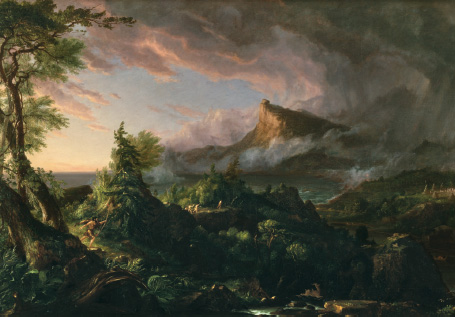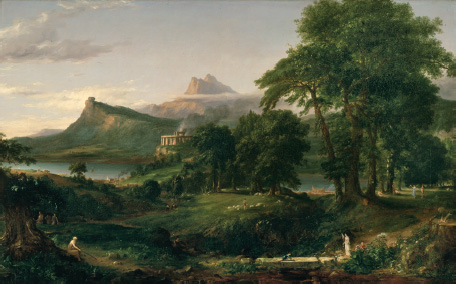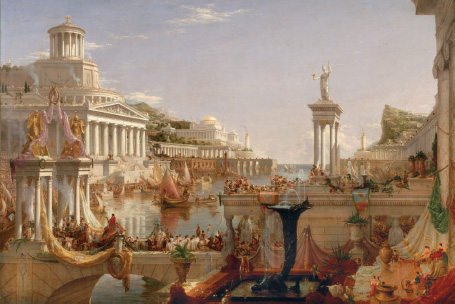
Part of what marked Thomas Cole out from his contemporaries, and other members of the Hudson River School, was that he did not limit himself to landscape. In the early 1830s he began to conceive of an epic series of five allegorical paintings that were to fuse landscape with another genre: history painting. The result, The Course of Empire, is more than an allegory; it is a prophetic warning in oil paint.
Like most significant works of art, The Course of Empire was a comment on its times, the so-called Jacksonian era. It was impossible, in the 1830s, for educated Americans not to sense that they were living at a time in which the tempo of history, and the rate of change and speed of invention and innovation, appeared to have accelerated. The nation was expanding westwards, and had attained population parity with Britain. The sheer size of America’s potential was breath-taking, but the deleterious costs of progress were already being felt. The nation’s wilderness, sacred to Cole and to millions who came after him, was at risk of being expunged. Also at risk was the original founding conception of America as a commonwealth of farmers, a pastoral nation of little men, free from the tyranny of monarchs or the yoke of an overbearing state. At this critical crossroads, under the controversial and divisive presidency of Andrew Jackson, Cole produced The Course of Empire, which reminded Americans of a simple fact – that empires fall as well as rise. The series was influenced by ideas that were current at the time which suggested that human history moves in cycles, and that there are natural phases in the civilisational process.
50. The Course of Empire: The Savage State.
Although conveying a message of national importance, The Course of Empire was commissioned for the private gallery of Cole’s New York patron Luman Reed, a wealthy merchant and enthusiastic collector. Each of the five paintings that make up the series demonstrates a different time of day, from dawn to dusk. Each is set in the same landscape: a natural harbour, with the sea visible in the distance. The mountains that loom over the harbour are unchanging despite the passing of time, while below a great human drama is being played out.
The sequence begins with what Cole titled The Savage State. It is early dawn on primordial Earth. A hunter chases a stag across a verdant, untamed landscape. The first light of day illuminates the scene, and in the distance a primitive settlement of animal skin tents can be seen. Cole described the painting as showing only ‘the first rudiments of society’.1

51. The Course of Empire: The Arcadian or Pastoral State.
The next painting in the sequence depicts what in some ways was Thomas Cole’s ideal. In The Arcadian or Pastoral State the nomads trekking with the herds have long gone, for the inhabitants of this fertile Eden have become agriculturalists: a farmer ploughs his field, a shepherd tends his flock. As food is now plentiful, and life has become ‘tamed and softened’, the elite no longer toil in the fields and have discovered the arts: music, dancing and poetry. In the distance, near where the simple tents of their ancestors had been erected, now stands a megalithic temple in which the citizens of this Arcadia worship their gods. In the pastoral state of civilisation, Cole suggests, mankind and nature live in happy equilibrium. But by the waterside stands the symbol of impending change. A longboat is under construction, hinting that the men of this society are destined to venture forth and forge an empire.

52. The Course of Empire: The Consummation of Empire.
53. The Course of Empire: Destruction.
The third painting is the literal and narrative centrepiece of this series, and was intended to be hung in the middle position. The Consummation of Empire, larger than the other paintings, is set at midday. The once sparsely populated harbour is now lined with classical structures of white marble – vast temples and huge, gaudy palaces. Every balcony and public space throngs with crowds, and the river bustles with ships of trade and war. What is absent from this urban landscape is nature; all the trees have been eradicated. Here Cole presents an opulent, powerful civilisation at what he called ‘the summit of human glory’. Although democracy appears to have developed, there has been no flowering of republican values here. Democracy has been corrupted by luxury and tyranny, as power and wealth have bred decadence and moral decay. At the centre of The Consummation of Empire is the emperor, shown marching into his great city ahead of a column of horses and elephants. Thousands have come out to celebrate the glories of their leader and the power of their civilisation: the scene groans with hubris.
54. The Course of Empire: Desolation.
The fourth painting, Destruction, depicts the moment the city is overrun by the forces of an unnamed enemy. The bridge across the bay on which the emperor made his triumphal entrance has collapsed, fires have broken out in temples and palaces, and statues of the gods have been toppled. Weakened by luxury and decadence, the populace of Cole’s imagined civilisation are no match for hardened, virile invaders.
In the final painting, Desolation, it is a melancholy dusk. Centuries have passed. The harbour is moonlit and devoid of human presence. Nature has recolonised the landscape, vines have wound their tendrils around broken marble columns, and saplings have pushed aside blocks of weathered marble to reclaim their territory in an act of re-purification.
The more optimistic and less perceptive reviewers of The Course of Empire interpreted the series as an allegory predicting the impending fall of the tyrannies and monarchies of old Europe, and the unstoppable rise of American democracy.2 Others saw the painting for what it was: a commentary on the America of the Jacksonian era. Many were troubled by Cole’s pessimism. Cole himself wrote of his despair at the decline of the ‘moral principle’ in America.3 With The Course of Empire he was able to remind the citizens of his adopted homeland of the republic’s foundational opposition to centralised power and traditional distrust of luxury and excess. The America of the 1830s, Cole suggested, had wandered from those essential principles. Through carefully staged allegory he warned that America’s exceptionalism was not so deep or so profound as to render the nation impervious to the great cycles of history or the immutable forces that he believed propelled them.4 Cole hammered home his central point in the newspaper advertisements that announced The Course of Empire, quoting lines from Canto IV of Byron’s epic 1812 poem Childe Harold’s Pilgrimage:
First Freedom, and then Glory – when that fails,
Wealth, vice, corruption.